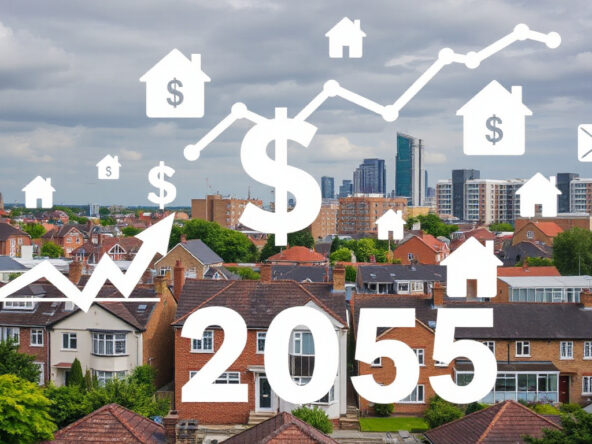In February 2025, the UK housing market demonstrated stable growth, marked by a
0.4% increase in house prices from January, a slight uptick from a marginal
0.1% rise the previous month. This resilience is notable given the backdrop of higher mortgage rates affecting borrowers. According to Nationwide’s chief economist, Robert Gardner, house prices rose by an average of
3.9% year-on-year, bringing the average property value to £270,493. Furthermore, housing transactions significantly increased by 14% in the latter part of 2024 compared to 2023, although they still lag behind pre-pandemic levels by 6%. Interestingly, first-time buyer activity appears to be rebounding, with mortgage completions for this demographic just 5% shy of 2019 figures. Recent data from HMRC disclosed that January 2025 saw 95,110 sales, a notable 14% increase from January 2024, albeit a mere 1% dip from December
2024. There’s been a noted decrease in first-time buyer inquiries during February, likely attributed to upcoming alterations in stamp duty legislation. The prospective changes, effective April 1, 2025, will lower the nil-rate band for first-time buyers from £425,000 to £300,000 and constrain eligibility for purchases up to £500,000. Concurrently, the standard nil-rate band for other buyers will decrease from £250,000 to £125,000, suggesting a forthcoming shift in buyer behavior due to these regulatory adjustments. This dynamic encourages a closer examination of how these changes will impact future market trends.
Key Takeaways
- The UK housing market experienced stable growth with a
0.4% increase in house prices in February
2025. - First-time buyer activity is recovering, with mortgage completions in 2024 nearly matching pre-pandemic levels.
- Upcoming changes in stamp duty are expected to significantly affect buyer behavior and market dynamics.
Current Trends in the UK Housing Market
The UK housing market is currently navigating a phase of tempered growth, characterized by a
0.4% uptick in house prices from January 2025, following a modest increase of
0.1% the previous month (Nationwide, 2025). This trend demonstrates a degree of resilience in the market despite prevailing high mortgage rates, with an annual growth rate of
3.9%, effectively placing the average property value at approximately £270,493. Robert Gardner, the chief economist at Nationwide, emphasizes that transactional activity has seen a 14% boost in the latter half of 2024 when compared to the same period in 2023; however, overall transactions still lag behind pre-pandemic benchmarks by around 6% (Nationwide, 2025). In terms of first-time buyers, their activities show signs of revival, with mortgage completions in 2024 documented as only 5% lower than those in 2019 (HMRC, 2025). According to HMRC data, January 2025 recorded 95,110 property sales, marking a notable 14% increase from January 2024, yet still a slight decrease of 1% from December 2024 (HMRC, 2025). Nevertheless, prospects for first-time buyers appear clouded by forthcoming changes in stamp duty regulations set for April 1,
2025. These amendments will see the nil-rate band for first-time buyers adjusted from £425,000 to £300,000, along with a drop in eligibility for homes valued up to £500,000. Concurrently, the standard nil-rate band for other buyers will reduce significantly from £250,000 to £125,000, impacting buyer sentiment (UK Government, 2025). Overall, the UK housing market is experiencing pivotal shifts that could shape buyer behavior dynamics in the near future.
Impact of Upcoming Stamp Duty Changes on Buyers
As the implementation date for these new stamp duty thresholds approaches, prospective buyers—including first-time buyers—are reassessing their strategies in the housing market. The reduced nil-rate band for first-time buyers means that more individuals will be required to pay stamp duty on properties within their price range, potentially reducing their purchasing power. Furthermore, with the standard nil-rate band’s reduction, existing homeowners may think twice before moving, fearing additional costs. This could lead to a slowdown in properties listed for sale, thereby exacerbating the existing supply constraints in the market. The uncertainty surrounding these changes is prompting many to accelerate their purchasing decisions ahead of the new rules, as buyers rush to take advantage of the current thresholds while they still apply. Market analysts suggest that these changes could usher in a phase of increased volatility within the housing sector, particularly affecting first-time buyers who are already grappling with the complexities of higher mortgage rates and limited housing stock (Smith & Co., 2024). Consequently, industry stakeholders are closely monitoring the effects on transaction volumes and pricing dynamics over the coming months as buyers adjust to these impending financial implications.




